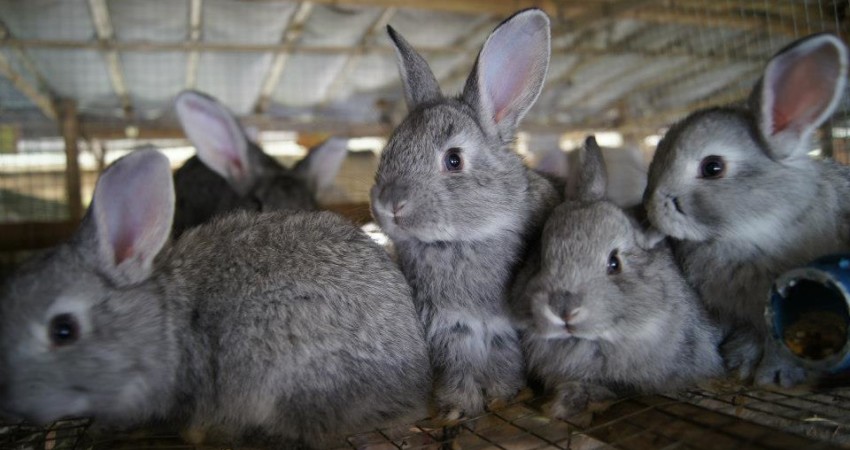

Rabbits are fast growing animals that take 4 – 5 months to mature for slaughter. They reproduce very fast, kindling (giving birth) four times a year to an average of 8 kits per kindle.
There are different breeds of rabbits available in Uganda, the California white, Chinchilla, Dutch, New zealand white, Flemish giant, French earlop and the Angora.
A male rabbit is called a buck while a female rabbit is a doe and their young ones are called kits.
Housing
Managing rabbits starts with constructing a proper house. A rabbit house is called a hutch and may be constructed with wood, concrete or iron sheets depending on the material available to you.
Each adult rabbit should occupy its own hutch that measures 2.5ft long, 2.5ft wide and 2 ft high. The weaned kits may be placed in hutches 4.5ft x 2.5ft x 2ft.
Every doe’s hutch should have a nesting box, where she will give birth and care for her litter.
The floor of the rabbit hutch should be made of chicken mesh reinforced with a wire mesh to allow dropping to pass through, keeping the rabbits in a clean and dry environment.
Most people use wood to make the floor of the rabbit hutch. This soaks rabbit urine and keeps the rabbit in a dump/ moist environment that is not easy to clean.
This makes the rabbits susceptible to sore hocks which are wounds found at the base of the rabbits limbs. These wounds make it hard for the rabbits to walks around and the buck’s ability to mount the doe during mating is compromised.
There should be a plastic sheet placed below the floor of the rabbit’s hutch to help collect the rabbit’s urine and droppings and this should be in a slanted direction to help the dung flow to a collecting gutter which also slants to a collecting point.
This makes it easy to clean and keeps the area dry. The outside structure that hosts the hutch can be made of wood or iron sheets.
The structure should face away from direct wind and the side that faces away from the direct wind should have a space between the roof and the wall for ventilation.
This space should be covered with chicken mesh to keep away cats and other animals, including rats.
Feeding
Rabbits are strict herbivorous and their diet should constitute of 80% fiber. Grass hay (Timothy hay or Rhodes grass) is rich in vitamin A and D, calcium, proteins among other nutrients.
Fibre promotes a healthy gastrointestinal tract and healthy teeth as rabbit teeth are constantly growing and lack of fiber in diet causes overgrowth.
Any leafy greens that are eaten by humans are also safe for rabbits. Sukuma wiki, carrot tops, ‘mchicha,’’mchunga’ etc are safe leafy greens for rabbits.
Other non leafy greens like cabbages and carrots can also be fed. It is important to gradually change from one leafy green to another as sudden change may cause gastrointestinal upset.
There are available commercial rabbit pellets in agrovets that can be fed to rabbit. A rabbits feeding schedule consists of:
• Birth to 3weeks – mother’s milk
• 3 to 7 weeks – mother’s milk and nibbles of pellets
• 2 months 50g per rabbit per day (weaned rabbit)
• 3 months 80g per rabbit per day (Introduce vegetables)
• 4 months 100g per rabbit per day
• Pregnant does 150g per rabbit per day
• Lactating does 200g per rabbit per day
Breeding
Rabbits are induced ovulators; their heat is stimulated by close proximity with a buck and ovulation will occur 10 to 12hours after mating.
When breeding, the doe should be taken to the buck’s cage and not vice versa. The buck marks his territory by urinating in his hutch.
The presence of the buck and the scent of his urine will stimulate the doe to be on heat and mating will occur. When the buck mates the doe he will fall flat on his back as a sign of successful mating.
The doe should then be taken back to her hutch.
A farmer may check the pregnancy status of the doe by gently palpating the abdomen a week after breeding. A small round mass will be felt as a sign of pregnancy.
A rabbit that is near kindling will remove her fur from the abdomen and place in the nesting box. This is meant to keep her kits warm as they are born without fur.
Once born, it is critical to check if the kits are feeding. Well fed kits will have smooth hydrated skin and will spend most of the time sleeping.
Kits that appear dehydrated and keep moving from one part of the nesting box to the other are hungry. This will indicate that the doe is not feeding her young ones.
You may need to foster those kits to other lactating does. When fostering, rub your hands in the fur of the doe that is receiving the kits and also use her fur to collect the kits and place them on the nesting box.
This is done to pick the scent of the new mother as she may kill the fostered kits with a foreign scent.
Common rabbit diseases
Rabbit diseases are mostly caused by poor hygiene and poor nutrition. The most common is coccidiosis caused by protozoan parasite that thrives well in most and dirty environment.
The other common condition is bloating; this causes high mortality in rabbits especially to weaners. This is caused by sudden change is feeds or through overfeeding of concentrates (rabbit pellets).
Rabbits can also be affected by snuffles, a disease that is brought about by a bacterial infection. Rabbits with snuffles tend to sneeze and have a running nose. There are many more common diseases.
Like other livestock enterprises, rabbit farming is profitable as long as good management.
 Contact Jaguza Support
Contact Jaguza Support